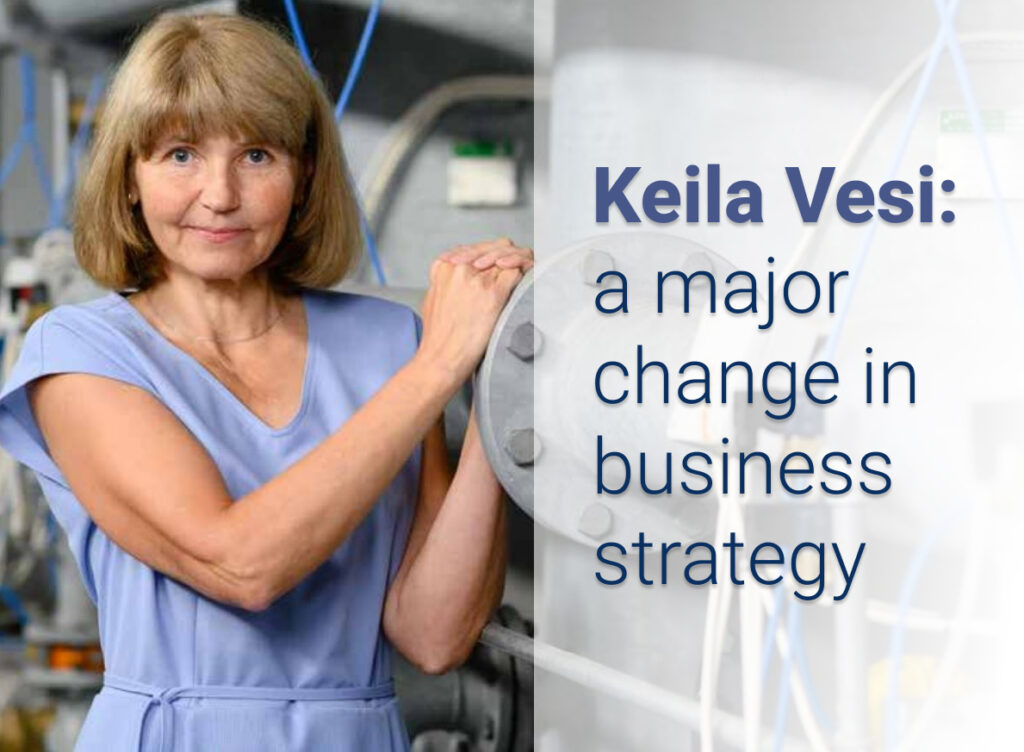Keila Vesi: a major change in business strategy made it necessary to change enterprise resource planning software
Source: Äri-IT Sügis 2022
Keila water company Keila Vesi has undergone major changes in the last four years – their number of employees has increased fivefold and the turnover of new business areas already exceeds traditional water management. To continue growing, updating their enterprise resource planning (ERP) software was an inevitable step.

Big blue water canisters are not carried to the water dispenser at the office of Keila Vesi – the machine offers the same drinking water that comes from the taps in people’s homes in Keila. And the people of Tallinn may be envious: drinking water is pumped from the Cambrian aquifer in Keila, mostly from a depth of 150 metres. But before it reaches the water supply system, all sorts of things are done with it. In one of the most modern water treatment plants in Estonia, groundwater is filtered through special sand filters, aerated (supplied with air), and excess iron and manganese are removed. All of this, of course, for the purpose of making the water taste good, being safe for human health and not clogging up the coffee machine. According to the norm, one litre of drinking water can contain up to 200 micrograms of iron – one litre of drinking water in Keila contains only 12.6 micrograms of iron.
The city of Keila has taken good care of its water management: over the past few decades, 95% of the water infrastructure has been reconstructed, and the work continues even now. Everything is in place, everything works. A few years ago, Keila Vesi even installed a couple of nice public drinking water taps in the city within the scope of the participative budget.
But to think that it is a comfortable workplace where people can simply let the time tick by is completely wrong. You could even say that four years ago, Keila Vesi was completely reborn. Since then, the number of employees has increased several times: from 9 to 52 employees. Namely, Keila Vesi has also taken over the tasks of the property management and street lighting maintenance of the Keila municipality. By now, things have reached the point where the turnover of real estate management exceeds that of water management.
‘It is not reasonable to keep all your eggs in one basket,’ says company manager Janno Jazõkov, whose previous work experience involved managing Estonian state real estate. Indeed, municipal enterprises can also reach a new level in their development if they only want to.
THE OLD SOFTWARE WAS BEHIND THE TIMES
The major change also led to the need for new ERP software. Since the previous MS Dynamics was set up purely for the water company, it was very cumbersome to reflect the revenue, expenditure and the projects of other business areas. And there are many projects in real estate management. In many ways, entering data became manual work, and this in a situation where the field of real estate was growing. That is why the company has been using Microsoft’s ERP software program Business Central since the beginning of this year.
The financial manager at Keila Vesi, Inna Allmere comments on what this means from the financial reporting perspective: ‘For the past few years, I often spent my evening working with Excel spreadsheets and trying to gather data, but now the rapid processing of data works. My dream of being able to handle my tasks during working hours has come true.’
She was also responsible for leading the implementation of the new software, because it was practically impossible to say no. ‘I knew that implementing new ERP software was a huge task, but I also knew that it was not possible to continue with the old program,’ notes Inna Allmere. ‘I didn’t feel very confident in the field of IT – I had only worked in finance after all and I had all kinds of doubts and hesitations. But my strongest side is determination: when I set out to do something, I finish it. It is a really good feeling to have learned something completely new.’
One of the reasons why Business Central was chosen was that the company was already using the predecessor of Business Central, Dynamics NAV.
Another thing that spoke in favour of Business Central – especially when thinking about the future – is that the software allows the possibility to create a unified environment where different projects and areas can be integrated, for example HR management. However, before the final decision was made, other ERP software systems were considered and, as expected for a public sector company, a competition was organised. BCS Itera emerged as the winner.
HAVING A TEMPORARY PROJECT MANAGER WOULD HAVE BEEN NICE
The implementation of the new ERP software started last year with workshops where the terms of reference were set. In other words, the goals the company wants to reach with the new software and the problems it helps to solve. On 1 January 2022, the balances were transferred to the new software – and then there was no way back.
‘Of course, it was a proper challenge. During the implementation, many people believed that we would get the new software working right away – they were not prepared for the fact that at some point we would have to organise the database and invest quite a lot of energy and time in it,’ Inna Allmere admits.
Janno Jazõkov adds that they did not start from scratch, as Business Central’s predecessor, Dynamics NAV, was already used. In retrospect, however, the company’s manager admits that changing business management software, which also means dismantling business processes down to the minute details, is a great deal of work. If he had the opportunity to do the whole process again, he would hire a separate project manager with experience in implementing this specific software application. ‘Our financial manager, who led the project from our side, had her share of sleepless nights and stress – it was a huge additional burden. After all, she had to do the work of the chief accountant at the same time. Impressive!’ If Keila Vesi had hired its own project manager for the implementation period, they would have been useful both in preparing the terms of reference and in providing input to BCS Itera.
The success and speed of the implementation depends to a large extent on the cooperation with the implementation partner, and the people at Keila Vesi have only good words to say about it. ‘The financial consultant at BCS Itera, Pille Nurmis never left us in trouble and solved all our problems.’
THE SOFTWARE SYSTEM IS THE FOUNDATION FOR EVEN MORE GROWTH
By now, when the new software has been in use for more than half a year, things have settled down and the people at Keila Vesi are already starting to plan the next steps. Janno Jazõkov explains: ‘Business Central is a very effective and powerful platform in the sense that the entire business process can be aggregated there, its parts can be analysed and, thanks to this, fragmented software can be abandoned. For example, we plan to integrate the payroll and HRM module. But this will not be done this year. We are talking about three or four years. When everyone, including first-level managers, is fluent in Business Central and doesn’t waste accountants’ time with their questions. And when all managers learn to make the necessary analyses with the help of new ERP software.’
The software change allows Keila Vesi to undertake another major change. Currently, the company manages the real estate of the local government in the broadest sense – from buildings to the maintenance of playgrounds, street lighting and traffic signs. In the future, the company also plans to enter the public market with this service.
Of course, the development of water management has not been forgotten. Namely, they are currently analysing what technology is suitable for cleaning the wastewater in Keila. Among other things, such questions as how to process mud and whether to build their own bio burner await answers.
However, when looking at the water dispenser in the office of Keila Vesi, could the high-quality water from the wells in Keila also reach the water dispensers in the offices of other companies there? And why not in a bottle on store shelves next to Evian, Haage and Värska? Janno Jazõkov smiles and considers it for a moment: ‘The bottling of water has been done in our company for several decades, but I don’t know the answer to why it was stopped. Probably it wasn’t profitable at the time. But I won’t rule out the possibility that we might take this direction in a few years.’
